
Hervé Carteau
THE SACRED ALLIANCE:
ONE GOD, ONE CHURCH, ONE KING
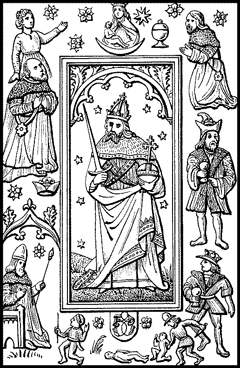 The Kingdom of Seshnela is one of Glorantha’s most powerful political entities. It rules over almost two million subjects and keeps on expanding. Seshnela is completely dominated by its King, working closely with the Rokari Church hierarchy. Both organizations are so tightly allied that one could not exist without the other.
The Kingdom of Seshnela is one of Glorantha’s most powerful political entities. It rules over almost two million subjects and keeps on expanding. Seshnela is completely dominated by its King, working closely with the Rokari Church hierarchy. Both organizations are so tightly allied that one could not exist without the other.
The Kingdom’s main strength derives from a very efficient social control system of its population. Most of the peasantry is bonded to local nobles, cities or church institutions. Peasants are used as labor force and cannon fodder for the King’s projects and as a source of prayer energy by the Rokari Church. Townsmen are enrolled in guilds; the army is under permanent watch by the Church.
Thus, Seshnela today is a powerful and repressive state, resting on a two-centuries old alliance between Crown and Church. But this alliance has sometimes been uneasy, and cracks are appearing between them at the end of this Third Age.
THE NINE GREAT SESHNEGI FIEFS
Duchy of Rindland (420.000 inh.), whose Duke has been King for two hundred years. The Duchy’s capital, Seguare, is also the nation’s capital.
Duchy of Tanisor (350.000 inh.) Its Capital is Arlor but its biggest city is Leplain, the Holy See of the Rokari Church, where the King’s edicts are second to those of Ecclesiarch Theoblanc. King Guilmarn eliminated the old ruling family and became Duke.
County of Estaurenic (250.000 inh.), whose capital is Estau. Count Guy de Loimbard is the hereditary ruler of the County and the Kingdom’s Marshall.
County of Deu (100.000 inh.) King Guilmarn also became Count.
County of Noyelle (100.000 inh.) Capital is Hingswell and the county is still ruled by its hereditary talar family.
County of Voï (150.000 inh.) King Guilmarn became the Count many years ago.
Barony of Vogai (100.000 inh.) The hereditary Baron cooperates fully with the King and his land is growing very rich from taxes on sea trade.
Barony of Gilboch Island (60.000 inh.) This island was recently obtained from the aldryami who are said to have abandoned it “for the sake of Lady Gwenelor”.
Dangim March (150.000 inh.) Main city is Dangk and the King directly rules this conquered land. It holds the Holy Site of Hrelar Amali, where Flamal grew and was cut down, still the site of many pilgrimages by theistic pagans.
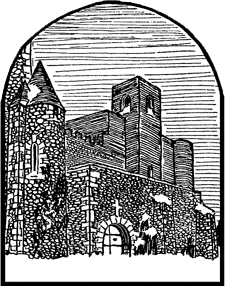 Seshnela is an agricultural land dotted by many towns and a few larger cities. Its social hierarchy necessitates having relatively small communities that are easier to watch and control by secular and religious authorities. The King strictly controls development of cities so they do not become impossible to manage. Only the Capital Segurane and the Holy See of Leplain are major cities with about 40.000 inhabitants each. Leplain holds the largest (but not highest) Malkioni cathedral in the World and is ringed. Segurane is still ringed by three successive defensive walls.
Seshnela is an agricultural land dotted by many towns and a few larger cities. Its social hierarchy necessitates having relatively small communities that are easier to watch and control by secular and religious authorities. The King strictly controls development of cities so they do not become impossible to manage. Only the Capital Segurane and the Holy See of Leplain are major cities with about 40.000 inhabitants each. Leplain holds the largest (but not highest) Malkioni cathedral in the World and is ringed. Segurane is still ringed by three successive defensive walls.
Seshnela’s backbone is the Tanier River, but its delta is in politically independent Nolos. Thus, the coastal region of Vogai and the island of Guilboch, the only maritime access of the Kingdom, are strongly developing with the creation of a royal navy.
All of Seshnela’s borders are dangerous. In the south, there is the duchy of Nolos with its very rich and corrupt, heretic, illegitimate rulers. In the east, there is the Tarinwood full of sinister elves and Safelster, a mosaic of crazed stygian city states. In the north, the trolls of Guhan and the brithini of Arolanit loom. In the West, the Kanthor Islands still hold the dreaded luathans and the western forests teem with obscene beastmen and the deluded Castle Coasters.
The Kingdom feels threatened on all sides and has always tried to expand its frontiers. The King’s priority is now to conquer Nolos and Pasos, his richest enemies. However, skirmishes frequently happen on all borders as many horali seek glory in battle to be promoted as Paragons. They try to whip the masses of levied bonded peasants to attack but they make very poor soldiers – unless possessed by the Spirit of the Crusade , when they become unstoppable.
THE SESHNELAN CASTES
Dronari (commoners)
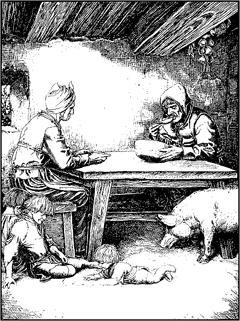 They make up over 80% of the population and their fate is quite different in the countryside and in the towns and cities.
They make up over 80% of the population and their fate is quite different in the countryside and in the towns and cities.
Rural dronari are mostly bonded to a landholder, city or church institution. They are serfs who don’t have the right to leave their lands or marry without the Lord’s permission. They can be drafted for war by the King and his representatives. They aren’t allowed to learn or cast any spell and must wear undyed clothes only. All must go to church every Sabbat, pray to Makan, confess their meagre sins to their Readers and then undergo more-or-less painful penance. However, many still follow the Old Ways in secret to get useful magics.
Only a few persons in each village are “free” dronari: the Readers, Craftsmen (smith, miller) and a few landed peasants maybe. Most are members of the Order of the Plow and actively cooperate with the authorities to keep their village in good order and enjoy their own relative well-being.
Urban dronari include artisans and tradesmen. They cannot read or write, touch any gold, ride horses or bear swords. They can only use spells appropriate to their caste. Dronari wear hose and tunics, and are associated with the color brown (work). Wealthy dronari wear fur-lined cloaks and tunics of bright colors (although never red, gold, white, or black). They carry their tools of work. In cities, many wear badges or trims from their guilds. Some may hold office in their cities.
Horali (Soldiers)
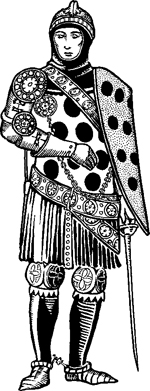 Seshnela’s army relies on commoners’ levies and horali, full-time soldiers are few in numbers. Many are NCOs who regularly drill the levies. Most follow the Order of Saint Iames (cavalry) or Saint Dalan (infantry). Horali wear baggy trousers and sleeved overcoats and must always carry their weapons prominently. They are associated with the color red (violence). There are horali in every royal county holding the office of Sheriff with the right of low justice; many also directly serve the Church as guards. The royal army itself has a few fully professional units. Most others are made of a cadre of horali leading levies of bonded peasants, poorly armed and motivated.
Seshnela’s army relies on commoners’ levies and horali, full-time soldiers are few in numbers. Many are NCOs who regularly drill the levies. Most follow the Order of Saint Iames (cavalry) or Saint Dalan (infantry). Horali wear baggy trousers and sleeved overcoats and must always carry their weapons prominently. They are associated with the color red (violence). There are horali in every royal county holding the office of Sheriff with the right of low justice; many also directly serve the Church as guards. The royal army itself has a few fully professional units. Most others are made of a cadre of horali leading levies of bonded peasants, poorly armed and motivated.
Among the horali are found the Paragons, the elite soldiers who lead the Kingdom’s armies to battle. The Crown rewards chosen horali with this title for their valor and discipline. Paragons must always own a sword. Rich Paragons have access to iron armor and weapons, often unenchanted to dampen enemy magic. Rokari Paragons follow a strict warrior code (akin to Bushido). All must belong to the order of Saint Gerlant Flamesword.
Guilmarn promotes his best and most loyal Paragons to high offices, giving them fiefs and offices to replace unreliable nobles. Thus they are slowly becoming the new ruler caste in the King’s lands. Most are absolutely loyal to the Crown and hope they will be allowed to hand their charges to their sons. They enjoy their new power very much, being ready to fight hard to protect it.
Talari (Lords)
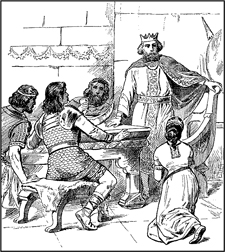 They are hereditary families charged with leading the people around them, “ensuring their material well-being”. Many talari families have genealogies traceable only from the start of the Third Age since nearly all GL supporters were wiped out before that. Only the head of a family has rulership over its land. He assigns roles to the other members as he sees fit. Many younger sons must join the army as commissioned officers, or the Clergy as high servants. By Ancient Law, talari are the only ones with the right to trade with foreigners and many of them are merchants.
They are hereditary families charged with leading the people around them, “ensuring their material well-being”. Many talari families have genealogies traceable only from the start of the Third Age since nearly all GL supporters were wiped out before that. Only the head of a family has rulership over its land. He assigns roles to the other members as he sees fit. Many younger sons must join the army as commissioned officers, or the Clergy as high servants. By Ancient Law, talari are the only ones with the right to trade with foreigners and many of them are merchants.
Thus the talari caste is as diverse as the others. Talari is a rank more than an occupation and there have been talari in all aspects of western society since it began. However, in Seshnela today, many traditional talari families opposed the growing power of the Crown and were dispossessed of their offices and lands. Many talari have been killed, others forced to enrol in the King’s army. Only the Barony of Estaurenic and the Counties of Noyelle and Vogai are still led by their historical talari rulers.
Many, but not all talari, belong to the Order of Saint Gerlant the King and have access to Ruling Magic. They wear ornate long-sleeved, coat-like garments that reach down below the knees and hats. They are associated with the color gold (authority). They carry a baton of authority. Ruling talari wear a jewelled ornament with feathers in their hat.
Zzaburi (Wizards)
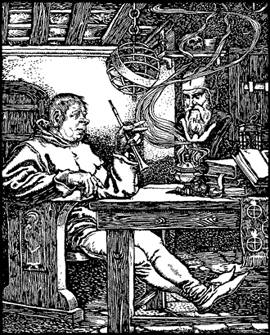 They are the upper Clergy of the Rokari Church and must guide the Community in spiritual matters according to Malkion’s and Rokar’s Laws. They must never shave their beard (a symbol of intelligence), use common tools or do any menial labor. They wear robes and are associated with the colors white (purity) or black (discipline). They wear high hats often made of fur and sometimes fur-trimmed overcoats.
They are the upper Clergy of the Rokari Church and must guide the Community in spiritual matters according to Malkion’s and Rokar’s Laws. They must never shave their beard (a symbol of intelligence), use common tools or do any menial labor. They wear robes and are associated with the colors white (purity) or black (discipline). They wear high hats often made of fur and sometimes fur-trimmed overcoats.
Seshnelan zzaburi are of two kinds. The ones belonging to the Rokari church venerate their Ecclesiarch Theoblanc who has made the Church so powerful. They must remain celibate. They focus on research on the Sharp Abiding Book, both to better understand it and to find ways of recreating Danmalastan. They are recruited in other castes at the age of 10-12 by wizards who examine all youths of this age.
Members of Saintly Orders and Schools not sanctioned by the Church are increasingly discouraged and persecuted. In fact, the Church lets a few run under constant watch by the Inquisition, only to use them as scapegoats when necessary. Some others have specific purposes which were approved by the Church, such as finding a way to fight off the Luathans.
Women
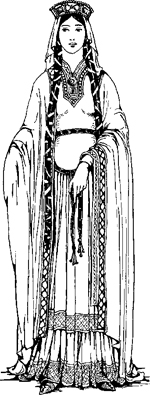 Women are from their father’s, then husband’s caste (which is, or should be the same). Rokari society is patriarchal and women are considered inferior to men. They are also the source of many temptations. They must obey their father, later their husband. They are mostly confined to domestic roles with a few exceptions such as the Order of Saint Elleish. Even the Order of Saint Xemela the Healer is under growing pressure by the Church and will someday soon be anathemized and disbanded.
Women are from their father’s, then husband’s caste (which is, or should be the same). Rokari society is patriarchal and women are considered inferior to men. They are also the source of many temptations. They must obey their father, later their husband. They are mostly confined to domestic roles with a few exceptions such as the Order of Saint Elleish. Even the Order of Saint Xemela the Healer is under growing pressure by the Church and will someday soon be anathemized and disbanded.
THE ROKARI CHURCH AND ROKAR’S MESSAGE
Rokar was born in Leplain in 1320 and soon recruited by the wizards (Nobody knows who Rokar’s parents were. Since Rokari wizards must remain celibate, they decreed Rokar himself had been adopted by the Church. Several regions claim to be his birthplace). He was Inspired by Malkion who gave him Knowledge of the Three Laws which had been lost during GL era. He said all pious people must venerate Makan, the One Mind, which separated matter and energy, the Creator from First Action, and uphold the caste laws spelled out Malkion the Founder (during Fourth Action) as a way to reach Solace after Life. Solace is accessible to all men who imitate the Prophet’s self sacrifice.Malkion’s Three Laws given to Rokar are the following:
“Nature is unclean and fosters sin.”
Gross matter slowly corrupts the purity of Man by accumulating impurities in us which prevent us to reach Solace. These impurities are called Sin. They must be removed to get closer to God by confession and penance. Hrestoli Joy is such an impurity.
“Sin can be purged by observing proper caste rules.”
Purging our body of sins makes us closer to God. Sin is everything that’s not in the Sharp Abiding Book. It opens the way to immortality as Theoblanc, Guilmarn and others’ very long lives prove this day. Caste laws approach perfection and bring us closer to God, they are our mean to salvation.
“The Church must be Purest among the Pure.”
The Church must be without any flaw and avoid the pitfalls of heresy, venality, simony and corruption. It must be under strict control all the time.Rokar began preaching this but was defrocked and declared heretic. He nevertheless continued preaching to the serfs, who were weary of war and troubles, and gained a large following. Finally, he was martyred in 1349 by the church. Many witnesses saw his essence going to Solace when he expired on the pyre and his message spread further. In 1410 Bailifes, Duke of Rindland, converted to the Rokari faith and crushed his enemies in 1412, being crowned King of Seshnela by Ecclesiarch Maldron in 1413.
THE HOLY BOOKS OF THE ROKARI CHURCH
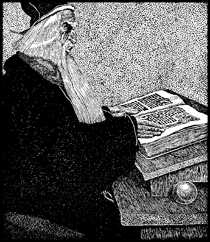
The first and most important is the Sharp Abiding Book , rediscovered by Rokar and later Ecclesiarch Maldron (1413-1564). It was originally written around 650 by the Return to Rightness movement, combining part of the Abiding Book and combat spells from the Grimoires of older sorcery schools. It states the only Right Laws, edicted by Malkion the Founder during Paseren (Fourth Action). Only Wizards of the highest levels of the church have access to the full Sharp Abiding Book.
Rokar himself wrote the Rule of Law using parts of the SAB used by the Return to Rightness Crusade before God Learners’ excesses. In it, he completely dismissed Hrestol’s teachings as “clever spells wrought by a clever but flawed man” but gives access to the power of the Crusade nevertheless. This is the Holy Scripture used by the whole church, from which extracts are read to the masses.
Ecclesiarch Theoblanc also wrote the Theoblanc Papers. In it, he explains the role of the Inquisition: it makes sure the Church remains pure, that no heresy will develop and that the wizards will not make the same mistakes as the GL did. He also warned of the dangers of iconolatry. Finally, he did clearly state the Church’s prerogatives. Theoblanc rails against ”the greased slope of chances, hopes and false dreams of success or power that slips into the infested and most base, putrid parts of our human souls. Hold to the Book."
WHAT IS NOT APPARENT IN THE HOLY SCRIPTURES
To the Ecclesiarch and his close advisers, Rokar’s message is meaningless. The wizards know the way to best serve God is to follow His Laws and live forever doing so. This is the only way to stop the infernal cycle of destruction and rebirth which plagues the world since Malkion’s Sacrifice. To bring the world with God again, Humanity must be stabilized forever, for its own good.The wizards, led by Maldron, picked Rokar’s message two centuries ago because it is simple and insists on caste stability and immutability. It thus is a good first step towards recreating the Perfect Society. To them, “Solace” is a useful way to channel the huge prayer energies of the Masses towards the New Danmalastan project. It has little, if any, spiritual meaning. But only the highest ranks in the Church are aware of that. It is an “inner circle” that has very different goals and philosophy from the rest of the Church.
THE ROKARI CHURCH’S HISTORY IN SESHNELA
In 1410, High Watcher Maldron converted the Duke of Rindland, Bailifes the Hammer, to the Rokari Church with its slogan “One God, One Church, One King”. In 1412, the Church unleashed the Power of the Crusade against Bailifes’ enemies, whom he crushed at the battle of the Asgolan Fields. The following year, Maldron was designated Ecclesiarch by the council of Watchers and crowned Bailifes King of Seshnela. The King’s first edict was to make Rokarism the Seshnegi state religion.
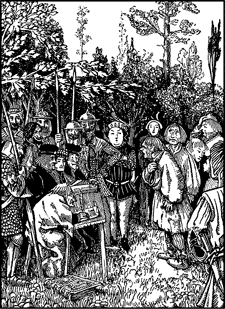 Maldron, a zzaburi student of the Sharp Abiding Book, had always desired to bring back society closer to God by recreating Danmalastan. He recognized the difficulty of doing so without strong support from the ruling caste. He and Bailifes made a pact: the King and his descendants would receive support and blessings from the Church, up to Crusade and possibly Immortality spells, as long as he gave the Church the necessary resources to help shape the future Land of Logic. Both swore powerful oaths which extended to their successors. Thus, the wizards had full protection and support from the crown to implement their program of bringing back the Land of Logic, the Perfect Society. The King gets extended Life and support from the Church to focus on rebuilding a powerful empire.
Maldron, a zzaburi student of the Sharp Abiding Book, had always desired to bring back society closer to God by recreating Danmalastan. He recognized the difficulty of doing so without strong support from the ruling caste. He and Bailifes made a pact: the King and his descendants would receive support and blessings from the Church, up to Crusade and possibly Immortality spells, as long as he gave the Church the necessary resources to help shape the future Land of Logic. Both swore powerful oaths which extended to their successors. Thus, the wizards had full protection and support from the crown to implement their program of bringing back the Land of Logic, the Perfect Society. The King gets extended Life and support from the Church to focus on rebuilding a powerful empire.
Church and State are thus bonded together and both depend on the other. None can break that pact easily. This pact’s real aim is a closely-kept secret, known only to a few top-ranking wizards and to the reigning King, who discovers it when he assumes power (part of the Crowning Ritual is in fact the Revelation of the Pact with all its implications to the new King. In fact, this is the core of the Ritual, and renews the Bond between Crown and Church). It has served Guilmarn well as he is now direct overlord of nearly three quarters of the population.
However, while the Church tries very hard to establish an absolute caste system, Guilmarn needs some social mobility to further his political agenda, both upwards and downwards. He replaces the unreliable nobility with his Paragons, who become landholders, mayors and sheriffs while still horali. Also, the rich dronari city burghers actively support the King in exchange for more rights in running their affairs and protection from harrying clerics. These aspects do not fit well with the wizards’ goal of stabilizing every man in his caste forever and created rising tensions between Church and Crown.
After the King’s failure to conquer Nolos in 1622, the Church draws the line at his renewed demands of full and unquestioning support to continue the war. Guilmarn wants to take back or tax the Church’s lands and Theoblanc formally opposes this. He calls for a Rokari conclave to discuss the issue in 1623. This stalls the King’s actions against Nolos until 1624. Tense negotiations last for over one year, and end up with an agreement: renewed support and acceptance of the Horali Paragons’ new role from the Church against total iconoclasm in the Kingdom. Theoblanc uses the King’s need for support to implement one of his ends: focussing all prayer energies on the New Danmalastan project without any waste due to veneration of the Saints.
After this accord is reached, a new Conclave will be called and Theoblanc will declare total iconoclasm in the Kingdom. All Watchers who disagree will be killed overnight by “demons”. All saintly orders and independent schools will be closed by the Paragons, their books confiscated and given to the new order of the Monks of the Cryptic Library .
Then, the Kingdom will attack Nolos and Pasos and conquer them, using the Power of the Crusade with great effect. For the coming years, the Church will temporarily tolerate Guilmarn’s policy as it strengthens its own hold on Seshnela and, all things considered, brings Danmalastan closer.
The Caste issue will remain a thorny one between Crown and Church. Some factions in the Church argue for bringing to order the urban dronari, who become too worldly. The burghers fight back using the Crown’s protection, based on the taxes they bring. Tensions are rising between about this subject. What will be the fate of Rokari townsmen?
THE ROKARI CHURCH TODAY
The Rokari church is at the top a philosophical order of wizards studying the Sharp Abiding Book. They advise the other Castes on how to conform to its Laws to “ensure the energetic well-being of the community”. For the Rokari wizards, this means bringing the community closer to the One Mind, Makan, by recreating Danmalastan, the Perfect Land of Logic. Thus they try to make everyone follow the Laws set in their holy books to the letter both as a way to harvest their prayer energies and to stabilize the social system.The original message of Solace from Rokar is but “window dressing” for the masses: it is simple to understand and has the Crown’s support. But it means very little to wizards in the know. Few in the Inquisition know that, and only at the highest level. Most Rokari churchmen sincerely believe they are helping their wards to go to Solace after their death.
The Church’s second, immediate priority is to prevent the return of hell on earth (ice age, continents shattered, etc) by making sure the wizards never start experimenting again. It lives in great fear of the past’s catastrophes, especially the one which destroyed half of Seshnela. To control wizards, it has built the Order of the Inquisition which closely monitors all of them. The Church tries to concentrate all knowledge of sorcery and forbids any use of any other magic in Seshnela. This goal is well known and shared by the whole Church hierarchy, down to the lowliest village Reader.
The Rokari Church hierarchy officially focuses all wizardry studies on the Sharp Abiding Book. It organized four schools of wizardry: Inquisitor’s School (to help the Golden Lance inquisitors to root out heresy), Defences of God (to protect the Church inside Seshnela), Iron Blood (to help the King’s armies to conquer and convert new lands) and Lordly Advisory (to advise and support the Crown, in fact keep an eye on it). The Church also tolerate a few independent sorcery schools as long they help specific, Church-approved purposes, such as finding a way to defeat the luathans, or are purely technical, such as the Humble Calligraphers.
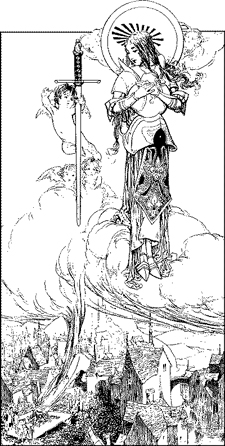 Saintly Orders are ultimately seen as distractions from the veneration of Makan and will be eventually all banished, even Saint-Xemela’s. Only the Orders of the Golden Lance (inquisition), of Gerlant (paragons) and Iames (military) and the Student Body (for converts who have experienced Joy before) are sanctioned by the Rokari church. All other orders (such as the Plow) are tolerated only, many others having been anathemized already. Theoblanc is becoming increasingly iconoclastic and has ordered many saintly images removed from sight or even destroyed.
Saintly Orders are ultimately seen as distractions from the veneration of Makan and will be eventually all banished, even Saint-Xemela’s. Only the Orders of the Golden Lance (inquisition), of Gerlant (paragons) and Iames (military) and the Student Body (for converts who have experienced Joy before) are sanctioned by the Rokari church. All other orders (such as the Plow) are tolerated only, many others having been anathemized already. Theoblanc is becoming increasingly iconoclastic and has ordered many saintly images removed from sight or even destroyed.
The Inquisition continually searches for heresy in the Church and society. Their agents keep a close eye on all wizards, but also regularly check on Readings of all castes, often attending incognito. They also infiltrate Guilds, army units, etc. and watch over all castes. An agent uncovering heresy must report it immediately to his superiors. The Order will send the Order of the Golden Lance’s members to crack down on it, either immediately or after a (terse) attempt to make the heretic see the Light. After purification, if the perpetrators are still alive and coherent, they are handed to the Crown’s justice.
Religious Ceremonies are called Readings and held separately for each caste and sex by some of their own members called Readers. Readers are NOT wizards but members of their caste who have the duty to read their holy scriptures to their brethren in addition to their usual work. Some may know a few Prayers as well. Readers are also in charge of administering common sacraments (baptism, confirmation, marriage, funerals) and a few special ones (bless militia, bless project, etc.)
Readers all report to a Watcher who in turns reports to a High Watcher. There are nine High Watchers in the Kingdom of Seshnela, one per great fief, though religious boundaries do not exactly fit the political borders. They directly answer to the Ecclesiarch, Saint Theoblanc the Pious, who holds office since 1564. The Ecclesiarch has final and absolute say on all Church matters.
Rokari wizardry has some particular aspects; it scorns all visible displays and focuses on efficiency. For instance, the Neutralizing of wounds looks and feels different from “regular” magical healing. Wounds did not exist in Danmalastan and thus have to be negated as they are not Logical.
HERESIES
Hrestolism is still alive even in areas dominated by the Rokari. Periodically people get glimpses of the Joy of Hrestoli and celebrate his Joy in confused ceremonies where people cry tears of joy, fall to their knees and pray to the Creator for allowing them just that glimpse of what awaits them. Plagues of frenzied (but very joyful) madmen wash through the rural lands until they are crushed by the soldiers of the inquisition or noble house responsible for that area.Sometimes a noble or a soldier gets a glimpse of Hrestol's Joy. The lucky ones leave Seshnela. There have been some secret Hrestoli communities with surprisingly powerful patrons. The Judges root out these communities and crush them before they return the madness and horror of the God Learners.
Among the serfs who do not use pagan magics, the flagellant heresy is gaining ground. Having nothing to hope for except solace, its members constantly mortify themselves to emulate the sacrifice of Malkion and go to Solace faster. Their processions are becoming commonplace and the inquisition is working hard to keep this new heresy in check.